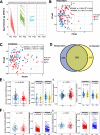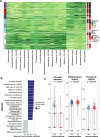Gut microbiome of helminth-infected indigenous Malaysians is context dependent
- PMID: 36476263
- PMCID: PMC9727879
- DOI: 10.1186/s40168-022-01385-x
Gut microbiome of helminth-infected indigenous Malaysians is context dependent
Abstract
Background: While microbiomes in industrialized societies are well characterized, indigenous populations with traditional lifestyles have microbiomes that are more akin to those of ancient humans. However, metagenomic data in these populations remains scarce, and the association with soil-transmitted helminth infection status is unclear. Here, we sequenced 650 metagenomes of indigenous Malaysians from five villages with different prevalence of helminth infections.
Results: Individuals from villages with higher prevalences of helminth infections have more unmapped reads and greater microbial diversity. Microbial community diversity and composition were most strongly associated with different villages and the effects of helminth infection status on the microbiome varies by village. Longitudinal changes in the microbiome in response to albendazole anthelmintic treatment were observed in both helminth infected and uninfected individuals. Inference of bacterial population replication rates from origin of replication analysis identified specific replicating taxa associated with helminth infection.
Conclusions: Our results indicate that helminth effects on the microbiota were highly dependent on context, and effects of albendazole on the microbiota can be confounding for the interpretation of deworming studies. Furthermore, a substantial quantity of the microbiome remains unannotated, and this large dataset from an indigenous population associated with helminth infections is a valuable resource for future studies. Video Abstract.
Keywords: Albendazole; Helminth; Indigenous population; Metagenomic sequencing; Microbiome.
© 2022. The Author(s).
Conflict of interest statement
Ken Cadwell has received research support from Pfizer, Takeda, Pacific Biosciences, Genentech, and Abbvie. Ken Cadwell was consulted for or has received honoraria from Puretech Health, Genentech, and Abbvie. Ken Cadwell holds US patent 10,722,600 and provisional patents 62/935,035 and 63/157,225. The other authors declare that they have no competing interests.
Figures




Similar articles
-
Helminth-Induced Human Gastrointestinal Dysbiosis: a Systematic Review and Meta-Analysis Reveals Insights into Altered Taxon Diversity and Microbial Gradient Collapse.mBio. 2021 Dec 21;12(6):e0289021. doi: 10.1128/mBio.02890-21. Epub 2021 Dec 21. mBio. 2021. PMID: 34933444 Free PMC article.
-
Temporal dynamics of gut microbiomes in non-industrialized urban Amazonia.mSystems. 2024 Mar 19;9(3):e0070723. doi: 10.1128/msystems.00707-23. Epub 2024 Feb 20. mSystems. 2024. PMID: 38376180 Free PMC article.
-
The Effect of Gut Microbiome Composition on Human Immune Responses: An Exploration of Interference by Helminth Infections.Front Genet. 2019 Nov 6;10:1028. doi: 10.3389/fgene.2019.01028. eCollection 2019. Front Genet. 2019. PMID: 31781154 Free PMC article.
-
Clinical helminth infections alter host gut and saliva microbiota.PLoS Negl Trop Dis. 2022 Jun 8;16(6):e0010491. doi: 10.1371/journal.pntd.0010491. eCollection 2022 Jun. PLoS Negl Trop Dis. 2022. PMID: 35675339 Free PMC article.
-
Eco-evolutionary implications of helminth microbiomes.J Helminthol. 2023 Feb 15;97:e22. doi: 10.1017/S0022149X23000056. J Helminthol. 2023. PMID: 36790127 Review.
Cited by
-
Gut-microbiome profiles among Soil-transmitted helminths (STHs) infected Ethiopian children enrolled in the school-based mass deworming program.PLoS Negl Trop Dis. 2024 Oct 15;18(10):e0012485. doi: 10.1371/journal.pntd.0012485. eCollection 2024 Oct. PLoS Negl Trop Dis. 2024. PMID: 39405336 Free PMC article.
-
Gut Microbiota and Parasite Dynamics in an Amazonian Community Undergoing Urbanization in Colombia.medRxiv [Preprint]. 2025 Apr 17:2025.04.16.25325921. doi: 10.1101/2025.04.16.25325921. medRxiv. 2025. PMID: 40321249 Free PMC article. Preprint.
-
Metagenomic analysis reveals the community composition of the microbiome in different segments of the digestive tract in donkeys and cows: implications for microbiome research.BMC Microbiol. 2024 Dec 19;24(1):530. doi: 10.1186/s12866-024-03696-5. BMC Microbiol. 2024. PMID: 39695983 Free PMC article.
-
Exploring the Effect of Gastrointestinal Prevotella on Growth Performance Traits in Livestock Animals.Animals (Basel). 2024 Jul 2;14(13):1965. doi: 10.3390/ani14131965. Animals (Basel). 2024. PMID: 38998077 Free PMC article. Review.
-
Multi-omics insights into the response of the gut microbiota and metabolites to albendazole deworming in captive Rhinopithecus brelichi.Front Microbiol. 2025 Apr 23;16:1581483. doi: 10.3389/fmicb.2025.1581483. eCollection 2025. Front Microbiol. 2025. PMID: 40336838 Free PMC article.
References
Publication types
MeSH terms
Grants and funding
LinkOut - more resources
Full Text Sources
Molecular Biology Databases

